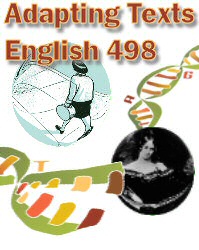|
|
Ghost World Case Study Grading
A 35- to 40-Point Essay (3.5-4.0, A
Range)
- Has a substantive thesis and essay fully addresses the topic;
the thesis is defendable, clearly explained, and supported in
the body of the essay
- Shows substantial depth, fullness and complexity
of thought
- Uses adaptation theory to shape and develop argument;
theory is integral component of the essay
- Expresses ideas clearly
and commands the reader’s attention
- Demonstrates clear,
unified and coherent organization
- Is fully developed and detailed
with arguments supported by persuasive reasoning and references
to text; there
is an appropriate balance
between providing evidence and analyzing that evidence
- Has a sophisticated style (remarkable variety of sentence pattern,
smooth transitions between ideas,
superior control
of diction)
- Properly cites source material
- Has few, if any, minor errors in
grammar, usage or mechanics
A 25- to 34-Point Essay (2.5-3.4, B Range)
- Has a clear thesis and essay addresses the topic but may not
do so completely; the thesis may be clear and well-argued, but
could
use additional support or development
- Shows some depth and complexity
of thought
- Uses adaptation theory to shape or develop argument
but references to theory may seem tacked on rather than closely
connected
to the essay’s claims
- Expresses ideas clearly
- Demonstrates effective organization
- Is well developed with sensible
reasoning and appropriate references to text; however, some evidence
may detract
from the thesis and some
ideas might not be fully explored
- Demonstrates balance
between evidence and analysis for the most part, but balance
may be weak in places
- Has an effective style (some variety of sentence
patterns, transitions between ideas, accurate diction)
- Properly cites source material, but may have errors in citation
format
- Has few errors in grammar, usage or mechanics
A 15- to 24-Point Essay (1.5-2.4, C Range)
- Has a thesis that may not be entirely clear and essay does not
fully address the topic
- Shows insufficient awareness of the complexity
of issues addressed; may treat the topic simplistically or repetitively
- Demonstrates little engagement with adaptation theory, offering
a few citations of theoretical texts, but not tying the references
to the essay in a clear manner
- Communicates ideas clearly
for the most part, but may have some lapses in clarity
- Has a
recognizable organizational pattern, but the relation among parts
is not consistently clear enough to provide
a coherent focus
- Is unevenly developed; writer may offer sufficient
reasoning or references to text for some of the ideas but not
for others
- Demonstrates some balance between evidence and analysis
- Has an
adequate style (limited variation in sentence patterns, transitions
between most ideas, diction
accurate for the
most part)
- Cites the majority of source material,
but occasionally material may be clearly cited but not referenced
in parentheses
- Has some errors in grammar, usage
or mechanics, but demonstrates basic control of these areas
A 7- to 14-Point Essay (.7-1.4, D Range)
- Has an unclear thesis; essay discusses the topic and meets basic
length requirements, but does not address the topic in any meaningful
fashion
- Lacks focus or demonstrates confused, stereotyped or
simplistic thinking; writer may demonstrate no overall conception
of the
issues raised by the topic
- Demonstrates misunderstanding of
adaptation theory, including references that have no connection
to the essay’s ideas
- May not communicate ideas clearly
- Is ineffectively organized,
with no clear relationship between the parts of the essay
- May
not provide adequate or appropriate reasoning or references to
support generalizations, or may provide
details without
generalizations
- Demonstrates little relationship between
evidence and the thesis
- Has stylistic weaknesses (no variety of
sentence patterns, few transitions, imprecise diction)
- Indicates
use of source material, but does not have consistent parenthetical
references
- Has occasional major errors in grammar, usage
or mechanics or frequent minor errors that
interfere in the reader's
understanding of the
essay
A 0- to 6-Point Essay (0-.6, F Range)
- Has no thesis or has an incomprehensible thesis that does not
engage the topic
- May be deliberately off-topic and demonstrate
no understanding of the issues addressed by the topic
- Does not
engage adaptation theory
- Does not communicate ideas clearly
- Lacks coherent organization
- Shows no development of ideas; may
simply summarize text
- Has an incoherent style (difficulties with
sentence structure, pattern of diction errors)
- Presents another
writer’s work as the author’s
own
- Has pervasive pattern of errors in grammar,
usage and mechanics that renders the essay unreadable
Last Update: 4/6/06
|



